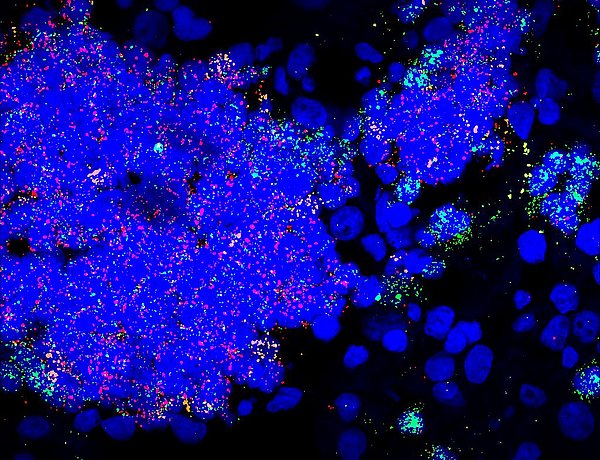The Hopp Children’s Cancer Center Heidelberg (KiTZ) is a joint institution of the German Cancer Research Center (DKFZ), University Hospital Heidelberg (UKHD) and the University of Heidelberg (Uni HD).
Neuroblastomas develop from immature precursor cells of the nervous system and occur in the adrenal glands, or along the spine – in the neck, chest or abdomen – particularly in infants and young children. In some cases, the tumor shrinks and completely disappears without any therapy at all. But in around half of all patients, it continues to grow, despite highly intensive treatment. Certain development processes in the human embryo determine whether the tumor disappears spontaneously or follows an adverse trajectory. This is the finding of a new piece of research conducted by scientists from the Hopp Children’s Cancer Center Heidelberg (KiTZ), the German Cancer Research Center (DKFZ) and the University of Heidelberg.
The most common place for neuroblastoma to develop is in the adrenal medulla. In order to investigate which cells and cellular development stages are relevant for this cell division defect, the scientists used single cell analyses to create a cell atlas of the developing human adrenal gland. Previously, this data had only existed for mice. “Using this atlas, we were able to define the cellular origin of neuroblastoma in humans properly for the first time,” explains Selina Jansky, the lead author of the paper, who works at the KiTZ, the DKFZ and the University of Heidelberg. “The origins probably lie in a group of adrenal neuroblasts, immature precursor cells of the nervous system, which only exist during a narrow window while the adrenal medulla is developing.” This finding differs from the findings of previous research carried out in mice.
In addition, the study showed for the first time that genetic development programs determine whether the cancer follows a favorable or adverse trajectory: tumors in high-risk patients activated genetic programs that most closely resemble those of immature, as yet undifferentiated precursor cells. By contrast, in neuroblastoma with a favorable prognosis, genes were active that were not switched on until later, when the cells are already specialized. “The process by which precursor cells develop into mature nerve cells appears to be blocked in the case of malignant neuroblastoma cells,” explains Frank Westermann, the leader of the study, who works at the KiTZ and the DKFZ. “This causes malignant neuroblastoma cells to enter a state of self-renewal, similar to that of stem cells, which can continue dividing indefinitely. This could also explain why they are so adaptable and quickly develop resistance to therapies.”
The study found that key factors involved in this blockage are the MYCN cancer gene and the TFAP2B protein. Neuroblastomas with a particularly adverse trajectory contain very high MYCN copy numbers. In addition, the TFAP2B protein, which is key to activating certain development genes and cell maturation, is missing. When the scientists switched off the MYCN genes and switched on the gene for TFAP2B, some of the cells started up their normal genetic development programs again.
The single-cell data that the team generated has been made available to scientists online in a specially programmed app for interactive browsing. “We are now hopeful that, with the help of this data, we will be able to identify the key genetic switches to reactivate the cell maturation process,” says Westermann. He also hopes that the results will help scientists develop better early diagnosis for children. “The tumors develop slowly and, unfortunately, are only detected between the ages of one and three. Our results show, however, that they probably develop early in pregnancy. This means that we also need to explore completely new avenues for early diagnosis.”
Original publication:
S. Jansky et al. Single-cell transcriptomic analyses provide insights into the developmental origins of neuroblastoma. In: Nature Genetics (online publication 25th of March 2021) DOI: 10.1038/s41588-021-00806-1
Press contact:
Dr. Alexandra Moosmann
Hopp-Kindertumorzentrum Heidelberg (KiTZ)
Referentin Presse- und Öffentlichkeitsarbeit
Im Neuenheimer Feld 130.3
D-69120 Heidelberg
T: +49 (0) 6221 56 36434
E-Mail:
E-Mail:




